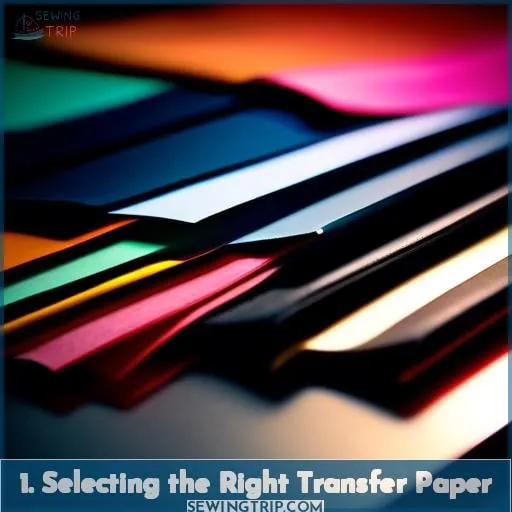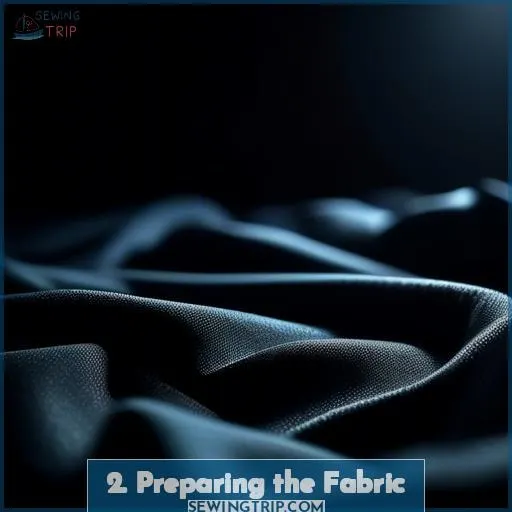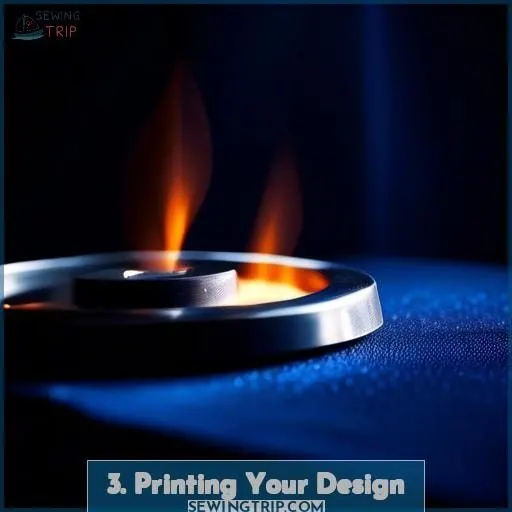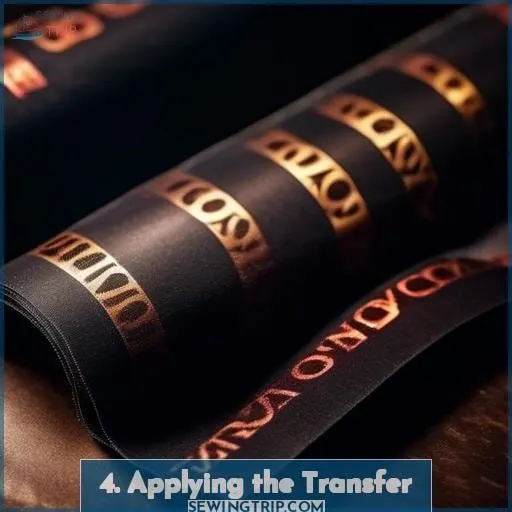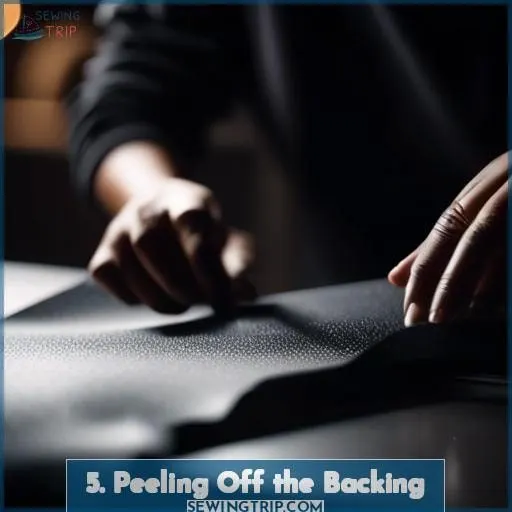This site is supported by our readers. We may earn a commission, at no cost to you, if you purchase through links.
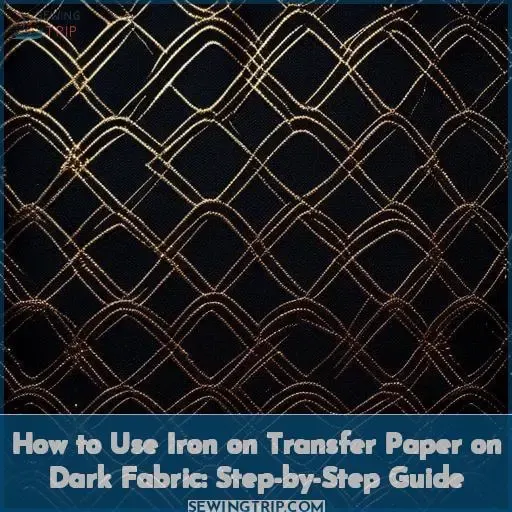 Unleash your creativity and transform your dark fabrics with ease using iron-on transfer paper! Whether you’re customizing t-shirts, bags, or any other dark textile, this guide will empower you to bring your unique designs to life.
Unleash your creativity and transform your dark fabrics with ease using iron-on transfer paper! Whether you’re customizing t-shirts, bags, or any other dark textile, this guide will empower you to bring your unique designs to life.
Get ready to express yourself and make a bold statement with your personalized creations. Here’s how to master the art of using iron-on transfer paper on dark fabric, ensuring your designs stand out with vibrancy and durability.
Yes, you can use iron-on transfer paper on dark fabric by printing your design normally (not mirrored), peeling off the backing, placing the transfer face up on the fabric, covering it with a silicon sheet, and ironing with firm pressure in small circles.
Use a dry iron on the highest temperature setting without steam, on a hard, heat-resistant surface.
Table Of Contents
Key Takeaways
- Use dark fabric transfer paper specifically designed for darker fabrics to ensure designs are visible and vibrant.
- Pre-wash and dry the fabric to remove finishes that may hinder adhesion and to prevent shrinkage that could cause the transfer to crack after application.
- Print the design without mirroring it, as dark fabric transfer paper does not require image reversal, and ensure the print quality is high with a resolution of 300 dpi and CMYK color profile.
- Apply the transfer with the image facing up, use a heat-resistant fabric or sheet to protect the image during ironing, and ensure the iron is set to the correct temperature (usually around 325°F or the cotton setting) with no steam.
1. Selecting the Right Transfer Paper
When customizing dark fabrics with your own designs, selecting the right transfer paper is crucial.
You’ll need to ensure it’s compatible with your printer—be it inkjet or laser—as this affects the quality and durability of your transfer.
Additionally, consider the longevity of the transfer paper and the method you’ll use to apply heat, as these factors will influence the final outcome on your fabric.
Compatible Printer Type
When diving into the world of customizing dark fabrics with your unique designs, selecting the right transfer paper is crucial.
- Inkjet Printer Compatibility: Most iron-on transfer papers are designed for inkjet printers, making them a versatile choice for home projects.
- Laser Printer Compatibility: For those with laser printers, options exist but are more limited. Ensure the transfer paper you choose specifies laser printer suitability to avoid damaging your printer.
- Home Printer Compatibility: Whether you’re using an inkjet or laser printer at home, there’s transfer paper available for you. Just double-check the product specifications.
- Professional and Commercial Printer Compatibility: For higher volume or professional quality, transfer papers compatible with commercial-grade printers are also available. This ensures durability and color fidelity on your dark fabric creations.
Fabric Color Consideration
After ensuring your printer is compatible, it’s crucial to consider the color of your fabric. Dark fabrics require specific transfer papers designed to make your designs pop with color vibrancy, even on the deepest blacks or navies.
When selecting transfer paper, look for options that promise high heat resistance and durability to withstand washing. The texture of your fabric also plays a significant role; smoother fabrics often result in clearer, more detailed transfers.
Lastly, consider the size of your image in relation to the transfer paper to maximize efficiency and minimize waste. Proper fabric preparation, including pre-washing without fabric softeners, will ensure the best adhesion and appearance of your design.
Transfer Paper Durability
When selecting iron-on transfer paper for your dark fabric projects, don’t overlook the importance of durability. You want your creations to withstand the test of time, maintaining their vibrancy and integrity through countless wears and washes.
Opt for transfer papers renowned for their longevity, ensuring they’ve undergone rigorous durability testing. Look for options that promise excellent heat resistance and fabric compatibility, guaranteeing your designs won’t fade, crack, or peel prematurely.
Washability is a key factor; your transferred designs should remain intact and as striking as the day you applied them, even after multiple laundry cycles. By prioritizing these qualities, you’ll ensure your custom garments look fantastic for longer, empowering you to express your unique style without compromise.
Heat Application Method
When selecting transfer paper for dark fabrics, the heat application method is crucial. You’ll need to adjust temperature settings carefully, ensuring they’re high enough to transfer your design effectively without damaging the fabric.
Dwell time, or how long you apply heat, is equally important. Too short, and the design won’t adhere; too long, and you risk scorching. Pressure application must be firm and even to ensure the transfer sticks properly across the entire design.
Finally, mastering peeling techniques, especially knowing when to peel hot or cool, can make or break the final look. Each of these elements plays a pivotal role in achieving a vibrant, lasting design on dark fabrics.
2. Preparing the Fabric
After selecting the right transfer paper, the next crucial step in creating vibrant designs on dark fabric is preparing the fabric itself. This stage is pivotal for ensuring that your creative vision comes to life with clarity and longevity.
Begin by thoroughly washing and drying your fabric to eliminate any finishes that might hinder the transfer’s adhesion. This step isn’t just about cleanliness; it’s about setting the stage for your design to shine.
Next, iron the fabric meticulously. The iron settings should be adjusted according to the fabric type to avoid damage while ensuring all wrinkles are smoothed out. This creates a flawless canvas for your artwork. Remember, the success of the transfer durability and the vibrancy of your design heavily relies on these preparation steps.
Proper temperature control during ironing is essential; too much heat can scorch the fabric, while too little may leave behind creases that could disrupt the transfer process.
Application techniques vary, but a common denominator for success is the fabric’s readiness to receive the design. By following these guidelines, you’re not just preparing a piece of fabric; you’re setting the stage for a masterpiece that embodies your desire for expression and the power of personalization.
3. Printing Your Design
Once you’ve prepped your fabric, it’s time to bring your design to life. Start by ensuring printer compatibility; not all printers work with heat transfer paper, so check if yours is inkjet or laser-specific.
File preparation is crucial for a high-quality transfer. Your image resolution should be at least 300 dpi to ensure sharp, clear prints. Color calibration is also key—adjust your file to a CMYK color profile for accurate color reproduction on dark fabrics.
Before you commit to the final print, run test prints on regular paper. This step helps you catch any errors and fine-tune the color and resolution, saving you time and transfer paper. Remember, the quality of your print directly affects the final product, so take the time to get it right.
With your design printed, you’re one step closer to a custom piece that exudes power and desire.
4. Applying the Transfer
After you’ve printed your design, it’s time to bring it to life on your dark fabric. Begin by ensuring your fabric is smooth and ready for the transfer paper placement. Iron out any wrinkles to create an even surface for the best results. Now, focus on the design orientation; remember, the image should face down on the fabric to transfer correctly.
Heat settings are crucial—preheat your iron to the cotton/linen setting without steam, as steam can interfere with the transfer process. Position the transfer paper carefully on the fabric, making sure it’s exactly where you want your design to be.
When you’re ready, apply the iron with firm pressure, using ironing techniques that involve large, circular motions. Start from the outside edges of the transfer and gradually move inward, ensuring all parts of the design receive heat evenly.
This method helps prevent scorching and ensures the entire design adheres well to the fabric.
Keep the iron moving for about 3 minutes, applying consistent pressure to bond the transfer to the fabric. Once you’ve ironed over the entire design, allow it to cool slightly before peeling off the backing.
If you’re working with dark fabric, you’ll have peeled the backing off before ironing. Check the edges to ensure they’re fully attached; if not, give them a bit more heat.
By following these steps, you’ll transform your dark fabric with a bold, personalized design that speaks to your desire for uniqueness and self-expression.
5. Peeling Off the Backing
Peeling off the backing paper from your transfer paper is the final step in bringing your custom design to life on dark fabric.
-
Let It Cool: After ironing, patience is key. Allow the transfer to cool completely. This cooling period is crucial for the adhesive to set properly, ensuring your design sticks to the fabric without issues.
-
Peel Carefully: Start peeling at a corner of the backing paper. If you encounter resistance or notice the design lifting, stop. This is a sign that the transfer hasn’t fully adhered. In such cases, re-iron the area with a focus on the edges and try peeling again.
-
Troubleshoot Adhesion Problems: If peeling remains a challenge, consider the following:
- Ensure you’re using high-quality transfer paper designed for dark fabrics, as poor-quality paper can lead to adhesion issues.
- Check your iron’s temperature and pressure applied during the transfer process. Insufficient heat or uneven pressure can prevent the design from sticking properly.
- If all else fails, applying a piece of masking tape to the corner of the transfer and the backing paper can help initiate a clean peel.
Frequently Asked Questions (FAQs)
How can I ensure the longevity of my design on dark fabric after multiple washes?
To maximize your design’s durability on dark fabric, wash it inside out in a mild 30-40°C cycle, avoiding bleach.
Iron it inside out—never directly on the print.
Is it possible to layer multiple iron-on transfers on dark fabric for a more complex design, and if so, how?
Yes, you can layer iron-on transfers on dark fabric for intricate designs.
Start with the base layer, press briefly, peel off.
Then add subsequent layers, pressing each lightly until the final press.
Can iron-on transfer paper for dark fabrics be used on synthetic materials like polyester, or is it limited to cotton?
Iron-on transfer paper for dark fabrics works on cotton and polyester blends. This type of transfer paper offers you the freedom to unleash your creativity on various textiles.
How can I correct or remove an iron-on transfer that has been mistakenly applied or is misaligned on dark fabric?
Ye olde iron-on mishap can be a real beast, but fear not!
To remove a misaligned transfer, gently heat it with an iron over parchment paper, then peel away.
If stubborn, dab with rubbing alcohol or nail polish remover and lift.
What are the environmental considerations of using iron-on transfer paper on dark fabrics, and are there eco-friendly alternatives?
Iron-on transfer paper can release harmful chemicals; opt for eco-friendly versions made from sustainable materials to empower your creativity while protecting the planet.
Unleash your style, sustainably.
Conclusion
So you’ve braved the labyrinth of iron-on transfer paper, armed with nothing but your wits and a hot iron.
You’ve wrestled with the beast of creativity and emerged victorious, your dark fabric now emblazoned with a design that’s as unique as your sense of humor.
Your custom designs won’t only reflect your personality but also stand the test of time.
Wear your creations with pride, knowing that you’ve mastered the art of making a statement without saying a word.

